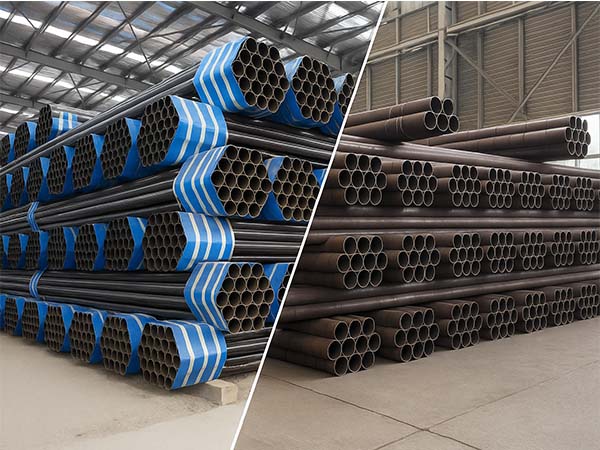In modern industry and infrastructure construction, pipelines, as key materials in areas such as structural support and oil and gas transportation, play a crucial role. How to select the model directly affects the quality, safety and economy of the project. Among various types of pipes,
seamless pipes and seam pipes have become the two most common types due to their unique manufacturing processes and performance characteristics. Next, I will conduct an in-depth analysis of their similarities and differences from aspects such as definitions, manufacturing processes to practical applications, to help you better understand seamless pipes and seam pipes.

What is seamless pipe?
Seamless steel pipe is a type of steel pipe without welds. It is formed by heating, piercing, rolling or extruding solid round steel or ingots into one piece without welding. Its main feature lies in that the pipe body has no welds, and the cross-section is uniform and continuous.
What is Seam pipe?
Seam pipe, as the name suggests, is a steel pipe with welds. It can also be called welded steel pipe, and its main raw materials are steel plates or steel strips. It is made by welding the edges of steel plates or steel strips into pipes through a forming process. It can mainly be classified into the following categories: ERW, LSAW, and SSAW pipes.
The difference between seamless pipe and Seam pipe
Comparison of production processes
Seamless pipes are made by piercing, extruding and rolling billets, while Seam pipes are produced by welding and fusing steel plates or steel strips through welding technology. Different production processes result in significant differences in their precision. The precision control of seamless pipes is high, with smaller tolerances for wall thickness and diameter. The precision control of Seam pipes is lower than that of seamless pipes, and the precision control depends on the welding and straightening processes.
Comparison of performance characteristics
Strength comparison: Seamless pipes have no welds, the metallographic structure of the pipe wall is uniform, and there are no weak points at the joints, thus possessing higher strength and uniformity. In contrast, Seam pipe has obvious welds. The metallographic structure at the welds is slightly discontinuous and the strength is relatively low.
Comparison of pressure resistance: Seamless pipes have outstanding pressure resistance and are particularly suitable for application in high-temperature and high-pressure fields. However, the compressive strength of Seam pipe is average and is mainly affected by the welding quality. However, with the continuous upgrading of welding technology, the welding quality of Seam pipe has been significantly improved.
Comparison of cost and efficiency
The manufacturing of seamless steel pipes is relatively complex, involving multiple processes such as piercing, rolling, and heat treatment, thus resulting in a relatively high production cost. Meanwhile, due to its high-precision requirements, the scrap rate in the production process is also relatively high, further increasing the cost. In contrast, the production process of Seam pipe is relatively simple. It mainly connects steel plates or steel strips together through welding technology. Therefore, the production efficiency is higher and the cost is relatively lower. Moreover, Seam pipe has rich sizes and specifications and can be customized for some specific project requirements.
Comparison of application fields
Seamless pipes, with their unique seamless structure, are particularly suitable for high-pressure environments, such as high-pressure transportation of oil and gas, boilers and heat exchange equipment, etc. In contrast, although Seam pipe is still strong, its ability to withstand pressure is not as good as that of seamless pipe, and it is usually applied in fields such as medium and low-pressure oil pipelines, water pipelines, and building structure supports.
Summary
When choosing seamless steel pipes and welded steel pipes, the specific requirements of the project must be fully considered. Seamless steel pipes demonstrate outstanding strength and reliability in high-pressure applications, while welded steel pipes have diverse functions, capable of meeting various construction and pipeline requirements, and at the same time helping to reduce costs.
